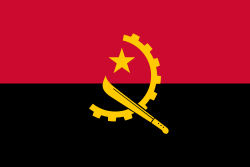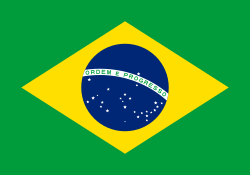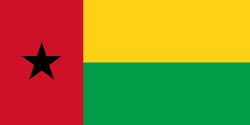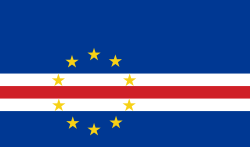Portugisisk (sprog)
| Portugisisk (português) | ||||||
|---|---|---|---|---|---|---|
| Talt i: | • Portugal og
| |||||
| Talere i alt: | 203.352.100[1] | |||||
| Rang: | 8 | |||||
| Sprogstamme: | Indoeuropæisk[2] Italisk Romansk Italovestlig Vestligtromansk Galloiberisk Iberoromansk Vestiberisk Portugisisk-galicisik Portugisisk | |||||
| Officiel status | ||||||
| Officielt sprog i: |
| |||||
| Reguleret af: | Instituto Internacional da Língua Portuguesa (dansk: Det Internationale Portugisiske Sproginstitut) Academia Brasileira de Letras (Brasilien) Academia das Ciencias de Lisboa, Classe de Letras (Portugal) | |||||
| Sprogkoder | ||||||
| ISO 639-1: | pt | |||||
| ISO 639-2: | por | |||||
| ISO 639-3: | por | |||||
 | ||||||
 For alternative betydninger, se Portugisisk. (Se også artikler, som begynder med Portugisisk)
For alternative betydninger, se Portugisisk. (Se også artikler, som begynder med Portugisisk)
Portugisisk er et sprog, der tales i Portugal, Brasilien og i de øvrige forhenværende portugisiske kolonier i Afrika, navnlig Angola, Mozambique og Kap Verde. Historisk set var portugisisk også brugt i Asien og Indien, navnlig i Macao og Goa. I disse områder er sproget stadig anerkendt som et officielt sprog af historiske årsager, men tales ikke ofte i lokalbefolkningen.
Sproget er en del af den romanske sprogfamilie, og er tættest beslægtet med galicisk, spansk og andre lokale sprog og dialekter i området. Portugisisk og galicisk var oprindeligt det samme sprog, galicisk-portugisisk, som blev talt omkring 1300-tallet.
Mere end 220 millioner[1] mennesker har portugisisk som deres modersmål, og 234 millioner taler sproget som andet- eller tredjesprog. Desuden findes der adskillige kreol-sprog, som drager på portugisisk, heriblandt Kap Verde-kreol og efter sigende Papiamento i Sydamerika, omend det kan være vanskeligt at definere hvad der af spansk og portugisisk oprindelse.
Se også
Kilder
- ^ a b c d "Languages of the World, Portuguese", Ethnologue, hentet 2011-02-15 (engelsk)
- ^ "Languages of the World, Language Family Tree" Ethnologue, hentet 2011-02-15 (engelsk)
Eksterne henvisninger
 Der findes også en Wikipedia på portugisisk.
Der findes også en Wikipedia på portugisisk.- Instituto Internacional da Lingua Portuguesa Arkiveret 21. december 2012 hos Wayback Machine (Det Internationale Portugisiske Sproginstitut) (portugisisk)
- Academia Brasileira de Letras (Brasilien) (Det Brasilianske litterære akademi) (portugisisk)
- Academia das Ciencias de Lisboa, Classe de Letras (Portugal) (Lissabons videnskabsakademi, afdeling for litteratur) (portugisisk)
- Comunidade dos Países de Lingua Portuguesa (Sammenslutningen af portugisisksprogede lande) (portugisisk)
- John Madsens portugisiske grammatik Arkiveret 17. november 2015 hos Wayback Machine
- John Madsens portugisiske online-ordbøger Arkiveret 11. december 2004 hos Wayback Machine
- Portuguese 101 Learn Portuguese online
| ||||||||||
| Spire Denne artikel om sprog er en spire som bør udbygges. Du er velkommen til at hjælpe Wikipedia ved at udvide den. |
|
Medier brugt på denne side
Flag of Portugal, created by Columbano Bordalo Pinheiro (1857–1929), officially adopted by Portuguese government in June 30th 1911 (in use since about November 1910). Color shades matching the RGB values officially reccomended here. (PMS values should be used for direct ink or textile; CMYK for 4-color offset printing on paper; this is an image for screen display, RGB should be used.)
Flag of São Tomé and Príncipe
The Flag of Europe is the flag and emblem of the European Union (EU) and Council of Europe (CoE). It consists of a circle of 12 golden (yellow) stars on a blue background. It was created in 1955 by the CoE and adopted by the EU, then the European Communities, in the 1980s.
The CoE and EU are distinct in membership and nature. The CoE is a 47-member international organisation dealing with human rights and rule of law, while the EU is a quasi-federal union of 27 states focused on economic integration and political cooperation. Today, the flag is mostly associated with the latter.
It was the intention of the CoE that the flag should come to represent Europe as a whole, and since its adoption the membership of the CoE covers nearly the entire continent. This is why the EU adopted the same flag. The flag has been used to represent Europe in sporting events and as a pro-democracy banner outside the Union.Lesser coat of arms of Portuguese India between May 8, 1935 - December 31, 1974. (The 1961 annexation of Goa wasn't recognized by Portugal until 1974.)
Lesser coat of arms of Portuguese India between May 8, 1935 - December 31, 1974. (The 1961 annexation of Goa wasn't recognized by Portugal until 1974.)
Forfatter/Opretter: Jpthefish, Licens: CC BY-SA 4.0












